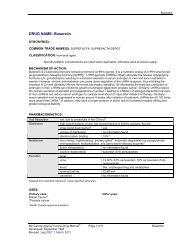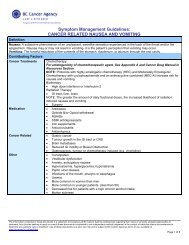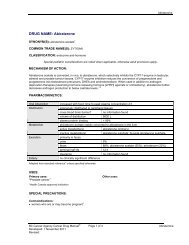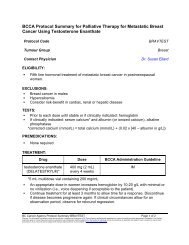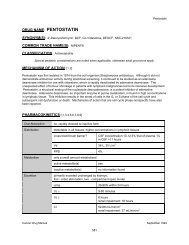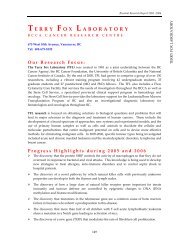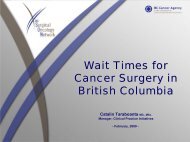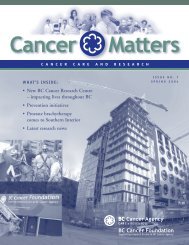Spring 2013 - BC Cancer Agency
Spring 2013 - BC Cancer Agency
Spring 2013 - BC Cancer Agency
You also want an ePaper? Increase the reach of your titles
YUMPU automatically turns print PDFs into web optimized ePapers that Google loves.
Lymphedema in the oncology patientThe following is a synopsis of a presentationgiven by Hamilton <strong>Cancer</strong> Centre nursepractitioner, Margaret Forbes, at the October2012 CAGPO meeting. Dr. Judith Pike, locumGeneral Practitioner in Oncology at the<strong>BC</strong> <strong>Cancer</strong> <strong>Agency</strong> Vancouver Centre,prepared the synopsis also available as aWebcast at www.fpon.ca (CME Initiatives).Lymphedema is the accumulation of excessprotein rich fluid in the interstitial spacedue to disruption of the lymphatic drainagesystem. In oncology this is most often dueto lymphadenectomy or radiation therapy,malignant involvement or a combination ofthese factors.The risk persists for life and is increased by:• More extensive surgery and/or acombination of radiation and surgery• Post operative complications e.g. infectionor hematoma• Trauma/Injury• BMI > 30• Immobility, dependent posture• Venous ThrombosisStages vary from mild, potentially reversibleto elephantiasis, with fibrosis, hyperkeratosiswith high infection risk.Lymphedema leads to:• Reduced mobility, stiffness and function.• Chronic debility, discomfort.• Negative impact on body image• Financial burden• Risk of infection, often septicemia. Abruptonset, usually due to gram +ve cocci; mayneed IV antibiotics if oral not quickly effectiveAssessmentBaseline limb volume calculation ormeasurements at 2-3 fixed points bilaterally;>2cm difference is significant. If occurs indelayed fashion, consider cancer recurrenceas possible cause.Prevention• Newer techniques such as sentinel lymphnode biopsy replacing radical lymph nodedissection.• If adjuvant radiation is anticipatedirrespective of nodal involvement, avoidingnode dissection may be prudent.Stage 3 Lymphedema• Avoid post op complications, skin or tissuetrauma.• Maintain limb strength and mobility.• Maintain ideal body weight.ManagementManagement includes patient education andself care with focus on• Skin care, lubrication, avoidance oftrauma, early recognition of infection.• Limb exercise, (gradual isometric toincrease mobility and strength)• Weight control• Compression * (sleeve, stocking, 2 layerbandaging, pneumatic compression) andmanual lymphatic drainage* Contraindications to Compression• Arterial Insufficiency• Congestive Heart Failure• Recent Venous thrombosis beforeanticoagulation established• Active Infection• Paralysis• Extreme caution required in diabeticsPoints to remember1. Diuretics are ineffective (fluid isextravascular).2. Ensure referral therapist is accredited.3. Garments require specialized fitting, aprescription with stated pressure.a. 20-30mm/hg for sleeve as toleratedb. 30-40 mm/hg for stocking as tolerated4. In institutionalized, palliative patientswith severe lower limb lymphedemasubcutaneous lower limb drainage is ofteneffective. A butterfly needle is insertedin the dependent lymphedematous limband attached to a drainage bag. (Nursingprotocol available at <strong>BC</strong>CA).Resourceswww.bcphysio.orgwww.bclymph.orgwww.massagetherapy.bc.cawww.canadalymph.cawww.voderschool.comwww.bccancer.bc.ca/PPI/Types of <strong>Cancer</strong>/Breast/Rehabilitation/default.htmwww.providemcehealthcare.org/health/professionals/referrals(Holy Family Hospital has a program forage >55, focuses on education and selfmanagement).www.fraserhealth.ca (Surrey Memorial)Contact Dr. Judith Pike atjpike@bccancer.bc.caTestimonials:“Workshop format (small group natureof the workshop) allowed for interactivediscussions”“Interacting with others and learning fromactual cases in a practical way”Upcomingworkshops andcall for facilitatorsView the full webcast of this topicat www.fpon.ca – CME Initiatives.CCOPEcontinued from page 1For details andregistration forupcoming workshops,or if you are a GPO or physician interestedin bringing the colorectal workshopsto your community, please visit www.ubccpd.ca/programs/ccope or contactTunde Olatunbosun at tunde.o@ubc.ca,604.875.4111 ext. 69138.FAMILY PRACTICE ONCOLOGY NETWORK NEWSLETTER / SPRING <strong>2013</strong> 3
Subcutaneous tumours – a surgical oncologist’s adviceBy Dr. Chris Baliski, ActingHead of the <strong>BC</strong> <strong>Cancer</strong> <strong>Agency</strong>’sSurgical Oncology Programand Surgical Oncologist atthe <strong>BC</strong> <strong>Cancer</strong> <strong>Agency</strong>’s SindiAhluwalia Hawkins Centre forthe Southern Interior.To excise or refer?Subcutaneous nodules are acommon presenting complaintto family practitioners, and afrequent referral to surgeons.The majority of abnormalitiesare benign with the mostcommon abnormalities beinglipomas and epidermoid cysts.Many other such entities canmanifest either within or deepto the skin including infections,inflammatory diseases, andrarely sarcomas. Lipomas generally will havea normal appearing epidermis, and tend to besoft but not hard, and have some mobility withrespect to the underlying tissues, except whenvery large. They also tend to be symmetrical inDr. Chris Baliski haspractised as a surgicaloncologist since 2002.His research and clinicalinterests focus on breastand endocrine cancersand melanoma. Dr. Baliskiis also Chair of the<strong>BC</strong> Surgical OncologyNetwork.shape. Epidermoid cysts tendto be much firmer, but alsosymmetrical, and often willhave a small central “pit”, andpossibly a history of recurrentinfections.If a mass is less than 2-3 cmin size, soft, not growingrapidly, and the patient isasymptomatic, excisionis within the purview offamily physicians assumingthey are comfortable withthe procedure. Situationswarranting increased attentioninclude those where the massis rapidly growing, greaterthan 5 cm in size, “deep to thefascia”, or has irregular or firmareas, and/or overlying skinchanges. If the abnormalitymeets any of the later findings, or if it islocated near a joint, on the extremities or theface, I recommend referral to a general orplastic surgeon to handle the excision.When cancer is suspected…If cancer is suspected, key logistical issuesduring referral can affect the definitivemanagement of the disease. I see patients,for example, who are not managed as quicklyas needed because the referring physician’slevel of concern is not clearly stated in theirreferral letter. This is especially importantas some specialist offices use support stafffor triaging. It is also helpful to provide allimaging reports for review, and an ultrasoundis often an easily accessible and costeffective measure as a first investigation.Although MRI is a valuable tool to helpcharacterize soft tissue masses, access tothis modality can be limited and can alsocause prohibitively long delays. It’s notuncommon, for example, for a patient towait 6-12 months for an MRI requested bya family physician. Surgeons often can getmuch quicker access to such imaging and Iencourage referring physicians not to wait foran MRI before referring a patient.continued on page 5Depression in brain tumour survivorsBy Dr. Douglas Ozier, PhD inCounselling Psychology, <strong>BC</strong><strong>Cancer</strong> <strong>Agency</strong>, PsychosocialOncology Research DivisionIt is estimated that 55,000Canadians are currentlyliving with a primary braintumour, with 10,000 peoplebeing newly diagnosedeach year. Brain tumoursmay either be classified asmalignant or nonmalignant.The implications of a braintumour diagnosis are diverse and profound.The 5 year survival rates for people withall kinds of glioma have recently beenestimated to be 27%, (Porter et al, 2010).The comparable survival rate for people withall nonmalignant primary brain tumours hasrecently been estimated to be 80%, (Porteret al, 2010). In addition to these implicationsfor mortality, a brain tumour can have diverseDr. Douglas Ozierand pernicious impacts on thesurvivors’ quality of life (Q of L).Included among these negativeimpacts can be functionalimpairments, cognitive deficits,mood disturbances, existentialdistress, personality changes,sleep issues, and pain (Pelletieret al., 2003; Fox et al., 2007).When medical professionalsare caring for a brain tumoursurvivor, regardless of the kindof brain tumour involved, it iscrucial for them to be alert to the possiblepresence of depression. This is important forthree reasons.The first is that depression is a very commonin brain tumour survivors. Evidence suggeststhat between 15% (Rooney, Carson, & Grant,2011) and 28% (Wellisch et al., 2002) of peopleliving with primary brain tumours wouldqualify for a diagnosis of major depressivedisorder. Regardless of the specific incidencerate considered, it is very clear that depressionis far more prevalent in this population than inthe general Canadian population.The second reason that depression is acrucial issue to consider when caring for braintumour survivors is that depressive symptomshave been found to be a key determinant ofoverall Q of L in this population. Pelletier et al.(2003) found that depression was the singlelargest predictor of overall Q of L in a cohortof 73 malignant brain tumour survivors. Infact, these authors found that “depressionscores alone accounted for more than half ofthe all variance in Q of L scores” (Pelletier etal, 2003, p. 47).The final reason is that, in glioma, depressionhas been linked to negative outcomes ina range of crucial domains beyond Q of L.continued on page 64 FAMILY PRACTICE ONCOLOGY NETWORK NEWSLETTER / SPRING <strong>2013</strong>
Rural family physician to city GPO – perspective on the moveAllison Rankin made a bigchange to her career a yearago when she opted toleave her long-time familypractice in Enderby and jointhe <strong>BC</strong> <strong>Cancer</strong> <strong>Agency</strong> teamof General Practitioners inOncology (GPOs) who work outof the <strong>Cancer</strong> Clinic at Vernon’sJubilee Hospital. To qualifyfor this new role, Dr. Rankincompleted the Family PracticeOncology Network’s eightweekGPO Training Programincluding an intense two-weekintroductory module at theVancouver Centre followed bysix weeks of clinical experience at the<strong>Cancer</strong> Centre and Clinic where her patientsreceive care.“The time was right for a new challenge andI’d been interested in this type of work forsome time especially the multidisciplinaryteam approach. Taking on the role of a GPO fitthe bill perfectly. I now work four days a weekat the Vernon <strong>Cancer</strong> Clinic with fellow GPOsDr. Chris Cunningham and Christine Blythand also work closely with our two medicaloncologists. The learning curve was steep,but the change was good.”“I found the Family Practice OncologyNetwork’s GPO Training Program highlyvaluable. The introductory module provideda great deal of information plus the chanceDr. Allison Rankin is nowa Vernon GPO followingcompletion of theNetwork’s GPO TrainingProgram.to make connections withnew colleagues who will beworking in the same field,to build contacts at theVancouver Centre and togain an appreciation for whathappens on the coast. It washelpful as well to learn aboutthe continuing educationoptions for primary careoncology and professionalgroups such as the CanadianAssociation of GPOs orCAGPO.”“Locally, my history inthe area fostered a usefuland comfortable level of interaction withphysicians many of whom with I already hadrelationships. They can walk in and talk withany of us at anytime – and many do – plusfeel free to call. We communicate regularly, inparticular, when patients transition from theclinic back to their family physician. Our teamof three ensures we meet the needs of thecommunity and that there is always someoneavailable – no gaps in care.Overall, I am thankful that the GPO TrainingProgram exists – <strong>BC</strong> is the only province tohave such a training program – and supportits continuation and ongoing development.I highly recommend this training to familyphysicians who will be working in the fieldand especially those with the opportunity tobring cancer care to communities in need.Dr. Rankin is originally from Ontario. Shegraduated from McMaster University MedicalSchool and completed her family practiceresidency in Ottawa. She maintained a familypractice first in rural Ontario and then inEnderby before making the move to Vernon.Contact Allison Rankin atallison.rankin@bccancer.bc.ca.Next GPO training course begins September 9, <strong>2013</strong>The GPO Training Program is an eight-week course offering rural family physiciansand newly hired <strong>Agency</strong> GPOs the opportunity to strengthen their oncology skills andknowledge. The program includes a two-week introductory module held twice yearlyat the Vancouver <strong>Cancer</strong> Centre followed by six weeks of flexibly scheduled clinicalmodules at the Centre where participants’ patients are normally referred. The program isaccredited by the College of Family Physicians of Canada for up to 25 Mainpro-C and 50Mainpro-M1 credits and eligible physicians will receive a stipend and have their travel andaccommodation expenses covered. For full details visit www.fpon.ca.Subcutaneous tumourscontinued from page 4Advice on biopsies and excisionsWith regard to biopsies, I caution againstperforming incisional or core biopsies. Theseare performed when there is a need to obtaina diagnosis prior to definitive excision.Complications such as hematomas andinfection can occur, or if done incorrectly canresult in the need for more extensive surgeryor radiation in the setting of a malignancy.They can also influence the interpretation ofthe lesions on later clinical examination orinfluence the quality of future imaging. Also, inmany cases image guided biopsy is preferableas it is more reliable diagnostic modality.If there is concern regarding the nature ofa soft tissue mass, I also caution againstexcisional biopsies in order to “get it out”.Once again this can be a disservice to thepatient requiring a much greater level ofintervention at a later date. In addition, ifconfronted with a situation in which duringthe actual excision there are concerns thatthe lesion may be more concerning thanoriginally thought, it is better to abortthe procedure rather than completing itfor the reasons previously elucidated. Inthis situation I would recommend a smallincisional biopsy.In summary, the majority of soft tissuesubcutaneous lesions are benign, andfamily physicians familiar with performingminor procedures should feel comfortableremoving them so long as they meet thecriteria previously stated. Generally, excisionsshould be performed utilizing Langer’s linesand locations near joints, distal extremities,and the face should be approached withcaution. If practicing in a remote region,extenuating patient circumstances precludeconsultation with a specialist, or you simplyhave a question regarding a clinical situation,I encourage discussion with a surgeon priorto any intervention.Contact Dr. Chris Baliski atcbaliski@bccancer.bc.caFAMILY PRACTICE ONCOLOGY NETWORK NEWSLETTER / SPRING <strong>2013</strong> 5
Head and neck cancer – an update for primary careBy Dr. Jonn Wu, Radiation Oncologist,<strong>BC</strong> <strong>Cancer</strong> <strong>Agency</strong> Vancouver CentreHead and neck cancer (HNC) includes a rangeof tumours which includes the oral cavity,oropharynx (tonsil, base of tongue), larynx/hypopharynx, nasopharynx, nasal cavity,paranasal sinuses, thyroid, and salivary glands.The worldwide incidence of HNC exceeds halfa million cases annually, ranking it as the fifthmost common cancer worldwide. This updatefocuses on squamous cell (ie. oral cavity,oropharynx [tonsil, base of tongue], larynx andhypopharynx) and nasopharyngeal carcinomas.Presenting symptoms are related to theanatomical site, and may include: cervicallymphadenopathy, hoarseness, dysphagia,odynophagia, referred otalgia, halitosis, illfittingdentures, nasal obstruction, epistaxis,headaches, diplopia (or other cranial nervepalsies), or non-healing mucosal ulcerations.View the full webcast of this topicat www.fpon.ca – CME Initiatives.HNC is associated with a large geographicvariability in incidence and site ofpresentation, which reflects the distributionof risk factors (ie. tobacco, alcoholconsumption), and ethnic/genetic variationsamong populations. Although HNC havebeen more common in elderly males, theincidence has been increasing in femalesas more women use tobacco and in youngnon-smokers as human papillomavirus (HPV)plays an increasing role in tonsil and baseof tongue cancers. Other risk factors includebetel nut chewing, radiation exposure,vitamin deficiencies, periodontal disease, andoccupational exposures (asbestos, saw dust).Diagnosis involves physical examinationand visualization of the cervical neck, oralcavity and oropharynx. Visualization of thenasopharynx, posterior pharynx and larynx isbest accomplished by mirror examination and/or the use of a flexible fiberoptic endoscope.Suspicious lesions should be biopsied.Imaging studies ie. CT, MRI and/or PET/CT areuseful to properly stage each new patient;the stage, in combination with the patient’sperformance status and personal preferenceswill help determine the recommendedtreatment regimens.Early stage disease is typically treatedwith either surgery (wide local excision)or radiation therapy; choice of therapy isdependent on the tumour site and potentialside effects. Surgery is commonly used in theoral cavity, whereas RT is more common in theother sites. For patients with locally advanceddisease, combined modality therapyparticularly with concurrent chemoradiationhave improved locoregional control, survivaland organ function preservation for manypatients. Other options include primaryDr. Jonn Wu chairs the <strong>BC</strong> <strong>Cancer</strong> <strong>Agency</strong>’sHead and Neck Tumour Group.surgery followed by either postoperative RT,concurrent chemoradiation, and sequentialtherapy (induction chemotherapy followed byconcurrent chemoradiotherapy or surgery).Patients are seen two to four weeks posttreatmentto assess tumour response andreview their sequelae. Imaging is usuallyreserved until 12 weeks afterwards todecrease the probability of a false positivefinding, which may lead to unnecessarysalvage surgery or interventions. Patients areseen more regularly during the first three tofour years since most (80-90%) recurrenceswill occur during this time; patients aregenerally discharged from the <strong>BC</strong>CA follow-upclinics after five years.Contact Dr. Jonn Wu atjonnwu@bccancer.bc.caDepression in brain tumour survivorscontinued from page 4Namely, in glioma, depression has beenfound to be associated with higher mortality,more frequent medical complications,(Rooney & Grant, 2010), and reducedfunctional status (Fox et al., 2007).If depression is identified in a brain tumoursurvivor then all of the usual managementstrategies, including pharmacologicaland psychotherapeutic options, can beconsidered in consultation with the patient.Two general depression related resourcesthat may be helpful are “Bounce Back”, a freeprogram offered at no charge by the CanadianMental Health Association, (www.cmha.bc.ca/how-we-can-help/adults/bounceback)and the online “Anti-Depression SkillsWorkbook” (www.comh.ca/antidepressantskills/adult/index.cfm).Regarding more brain tumour specificresources, The <strong>BC</strong> <strong>Cancer</strong> <strong>Agency</strong> Centers inthe Lower Mainland, Victoria, and Kelownarun monthly, professionally led brain tumoursupport groups (www.bccancer.bc.ca).These groups are not targeted towarddepression management, but instead offera forum for mutual support and informationsharing. If a patient is deemed functionalenough to likely benefit from a meetingof this kind, these support groups can bean invaluable source of encouragementand hope. Survivors can also be referredto the National Brain Tumour Foundationof Canada website (www.braintumour.ca).Again, while this organization does not offerspecific support for depression, it doesoffer a number of services that could help toinform, support, and empower the depressed(or non-depressed) brain tumour survivor.Their web site offers: reliable informationon brain tumours; a chance for survivors toconnect with each other in a safe, moderated,online community; and access to qualifiedprofessionals capable of offering livetelephone support.References for this article are includedwith the online version of this newsletterat www.fpon.caContact Dr. Douglas Ozier atdozier@bccancer.bc.ca6 FAMILY PRACTICE ONCOLOGY NETWORK NEWSLETTER / SPRING <strong>2013</strong>
Message from the chairBy Dr. Phil White, Chair andMedical Director of the FamilyPractice Oncology Network andfamily physician in KelownaWe’ve taken a two-prongedapproach to activities at theFamily Practice OncologyNetwork of late, focussingon closer relationships withour colleagues in otherprovinces and building strongerpartnerships within British Columbia’s owncancer care system. Our Western Collaborativeon Primary Care Oncology, for example,brings new connections from like-mindedorganizations in Alberta, Saskatchewan andManitoba. Their presence at our Council tablebrings fresh insights into the development ofour General Practitioner in Oncology TrainingProgram and other efforts –much appreciated.We are also in regulartouch with oncology groupsacross the country to betterunderstand the breadthof cancer care guidelinesavailable and to takeadvantage of published effortsthat will complement our ownguideline initiatives targetedto primary care. The sheer volume of resourcesand work underway in this realm is impressiveand will be useful as we move forward with ournext guideline on HPV related head and neckcancers.Here at home, we are working closely with the<strong>BC</strong> <strong>Cancer</strong> <strong>Agency</strong>’s Provincial SurvivorshipInitiative which is admirably bringing all theplayers in this field together to strategicallyimprove the follow-up care and resourcesneeded to enhance the health and the livesof cancer survivors. Family physicians arepatients’ key contact for 80% of survivorshipissues and we are delighted to be involved.Finally, I am pleased to welcome Dr. RaziyaMia to the Network team. As our new ClinicalCoordinator of FPON Education, Raziya will beheading up the planning for our November 2Family Practice Oncology CMEDay as well as leading organization of ourGPO Training Program along with otherprimary care CME offerings. Raziya will alsobe helping launch new initiatives such asour GPO Advanced Education Webcasts.Welcome Raziya!Contact Dr. Phil White atdrwhitemd@shaw.caAnnouncing Phase II for CAMEOBy Dr. Lynda Balneaves and the CAMEOResearch TeamThe Complementary Medicine Education andOutcomes (CAMEO) research team is pleasedto announce the next phase of our knowledgetranslation program. The CAMEO programis transitioning to an online platform fromwhich we can translate and contextualizeour findings to other settings in Canada andabroad.Over the past 4 years, the CAMEO researchteam has designed and evaluated anumber of complementary medicine (CAM)education and decision support interventionsfor patients, families, and health careprofessionals throughout <strong>BC</strong>. Through theseresearch projects, the CAMEO program hasoffered CAM education and decision supportto over 1,200 patients, families and healthcare professionals. Over the coming months,a number of <strong>BC</strong> <strong>Cancer</strong> <strong>Agency</strong> rounds,conference presentations, and peer-reviewedpublications are planned to share with youour research findings and recommendationsfor clinical practice and future research.These will be listed on our website.Our CAM information and decision supportresearch projects are now closed torecruitment. We are no longer able to respondto individuals’ questions about CAM (viatelephone, email, or in person) or acceptpatient referrals for CAM decision support.Many resources still availableand more to comeThe CAMEO website, at www.bccancer.bc.ca/cameo, will be maintained for theuse of patients, families, and health careprofessionals. It contains useful links tocredible, evidence-based CAM websites,tools like our CAM and <strong>Cancer</strong> in BritishColumbia and CAM Use Diary to help healthcare providers and patients make evidenceinformedCAM decisions, and links to CAMrelatedresearch projects. Over the next twoyears, new information resources, educationprograms—including new on-line health careprovider and patient education programs—and decision support tools will be developedand made available on a CAMEO website forall to use.Health care provider supportcontinuesWe continue to be committed to supportinghealth professionals to develop CAMknowledge and decision support skills tobetter address patient and family CAMrelatedneeds in the clinical setting. Pleasefeel free to contact us at cameo@bccancer.bc.ca to discuss ways in which we may beable to support your CAM information anddecision support needs. Also let us knowif you would like to be added to our list forCAMEO announcements as we launch ournew online resources and courses.FAMILY PRACTICE ONCOLOGY NETWORK NEWSLETTER / SPRING <strong>2013</strong> 7
Hereditary breast cancer – A case studyBy Melanie Taylor, ClinicalCoordinator, and Mary McCullum,Nurse Educator, Hereditary<strong>Cancer</strong> Program, <strong>BC</strong> <strong>Cancer</strong><strong>Agency</strong>Our patient was a 36 year oldunaffected female referred to theHereditary <strong>Cancer</strong> Program forpossible hereditary breast andovarian cancer syndrome (HBOC).Her family history was suspiciousfor HBOC with a sister diagnosedwith breast cancer at age 35 andtheir mother diagnosed at age53. Additional family history ofcancer included a maternal unclewith colon cancer at age 52,maternal grandmother with coloncancer at age 85, and paternalgrandmother with breast cancerat age 65.The family was eligible for BRCA1and BRCA2 genetic testing andbecause it is preferable to testan affected family memberfirst, testing was offered tothe patient’s sister. (BRCA1and BRCA2 are the genes mostcommonly associated withhereditary breast cancer risk.)This testing was performedand was uninformative (nomutation identified). Our patientwas counselled that althoughBRCA1/2 didn’t appear to becausing breast cancer risk inthe family, we couldn’t rule outa hereditary factor. She wasasked to recontact her geneticcounsellor with changes in thefamily history and for updates intesting options.Our patient returned four yearslater with new information. Hersister, who previously had breastcancer, had been diagnosed withuterine cancer at age 43 anddied at age 44. Our patient wasalso exhibiting new symptomsincluding the diagnosis ofmultinodal goiter. During clinicalreassessment it was also notedshe had macrocephaly. This newclinical information along withthe addition of uterine cancer inthe family raised the suspicion ofCowden syndrome due to a PTENgene mutation. Genetic testingidentified a PTEN gene mutationin our patient.Cowden syndrome (CS) is arare cause of hereditary breastcancer. It is characterized by highrisk for benign and malignanttumours of the breast, thyroidand endometrium. The majorityof individuals with CS havemacrocephaly and distinctskin lesions (trichilemmomas,papillomatous papules).continued on page 10Late medical problems and additional health care needs of breast cancersurvivors in <strong>BC</strong>By Olivia Tseng, MD, MSc,PhD student, InterdisciplinaryOncology Program, U<strong>BC</strong> and<strong>Cancer</strong> Control Research, <strong>BC</strong><strong>Cancer</strong> <strong>Agency</strong> (<strong>BC</strong>CA) and MaryMcBride, Distinguished Scientist,<strong>Cancer</strong> Control Research, <strong>BC</strong>CAImproved therapies andsupportive care have dramaticallyimproved survival of womenwith breast cancer. Five-yearsurvival for women with breastcancer in <strong>BC</strong> is now almost90%, and there are currentlyabout 44,000 survivors in<strong>BC</strong>. However, the disease andits treatment also contributeto acute and late-occurringchronic medical problems,including second cancers,heart failure, coronary arterydisorder, diabetes, osteoporosis,premature menopause,infertility, depression, anxiety,lymphedema, fatigue, andchronic pain. Our <strong>Cancer</strong> ControlResearch Survivorship Programhas been examining long-termmedical problems and relatedneeds for care among womenwith a prior breast cancer in <strong>BC</strong>;results will guide strategies andinterventions to improve theirongoing health.It appears that women survivingbreast cancer are approximately80% more likely to have amedical problem leading tohospitalization in the next 20years than women their agewho never had a breast cancer.The most common reason forhospitalization is cancer (eithera recurrence or a new cancer).However, 55% of survivors arehospitalized for non-cancerrelated conditions (about 62%more often than similarly agedwomen without a prior breastcontinued on page 98 FAMILY PRACTICE ONCOLOGY NETWORK NEWSLETTER / SPRING <strong>2013</strong>
New insights into ovarian cancer !By Dr. Dianne Miller,Gynaecologic Oncologist,<strong>BC</strong> <strong>Cancer</strong> <strong>Agency</strong>,Vancouver CentreEpithelial ovarian cancer isbecoming vanishingly rare.It would be nice if we werepreventing these cancersbut instead what we aredoing is re-classifyingbased on a much betterunderstanding of the pathophysiologywhich we hope will eventuallylead to possible screens, prevention andbetter treatment.Dr. Dianne Millerat risk families in ourpopulation and be able to offerrisk reducing surgery. Removalof the tube at hysterectomyor tubal ligation has receivedmuch of the press. Bycombining these two initiativeswe should conservatively overthe next 20 years be able todecrease the incidence of thisdeadly cancer by up to 40%.The second and third mostcommon epithelial cancers, the clear celland endometriod cancers are cancers ofendometriosis and not true ovarian cancerseither. We are currently engaged in researchto determine what factors are important inthe development of these malignancies. Ofnote, most of the decrease in ovarian cancerincidence attributed to tubal ligation is inthe endometriod and clear cell subtypes.For more information on these andother findings visit www.ovcare.ca.View the full webcast of this topicat www.fpon.ca – CME Initiatives.Until recently all of the epithelial tumourswere thought to arise from the surfaceepithelium of the ovary (OSE). We now knowthat for the High Grade serous cancer whichaccount for about 70% of the total epithelialovarian cancers, about 3/4 actually developin the distal fallopian tube not the ovary.In British Columbia, almost 20% of womendiagnosed with ovarian cancer have had ahysterectomy done prior to the diagnosis anda similar number have had tubal ligations. Inaddition, over 20% of the women with highgrade serous cancers will have a mutation ineither BRCA 1 or 2. These two facts are thecornerstone of our “British Columbia Ovarian<strong>Cancer</strong> Prevention Initiative”. Throughreferring all women with high grade serouscancer for genetic testing we should be ableto ultimately identify most of the geneticallyBreast <strong>Cancer</strong> Survivors in <strong>BC</strong>continued from page 8cancer). It appears that all organ systemsare adversely affected after breast cancer.Radiation treatment is the most toxic therapy;more extensive disease at diagnosis, olderage upon diagnosis, more recent diagnosis,cancer relapse and second cancers alsoincreased the chance of later problems.Approximately 98% of breast cancersurvivors visited a general practitioner in athree-year period, and 83% visited at leastone specialist. Survivors were 13% morelikely to visit specialists, especially generalsurgeons and plastic surgeons, most oftenfor reconstructive surgery. Breast cancersurvivors were also 6% - 12% more likely toreceive tests such as blood work and x-rays.This information demonstrates thatsubgroups of breast cancer survivors havehigh ongoing care needs, similar to otherconditions requiring complex care. The familyphysician is seen as primarily responsible forsurvivor care. However, current survivor careis suboptimal, as general practitioners arenot provided with the information and toolsfor risk-based care, including: awareness ofhigh-risk patients and late effects of breastcancer; risk-based guidelines for surveillanceof future cancers and late effects; a poorlydefined survivor care role for generalpractitioners; poor information exchange andcoordination between general practitionersand oncologists; and discordant expectationsof responsibility for care among generalpractitioners, oncologists and survivors.General practitioners however, can play akey role in survivor care, as oncologists areunable to care for non-cancer issues, andgeneral practitioners can coordinate specialistcare based on individual patient needs.Providing information to address these issuesis the goal of our breast cancer survivor study.Contact Mary McBride atmmcbride@bccrc.caFAMILY PRACTICE ONCOLOGY NETWORK NEWSLETTER / SPRING <strong>2013</strong> 9
Lymphoma overview for general practitioners – a diverse arrayof disorders with a multitude of treatment optionsBy Dr. Laurie Sehn, MedicalOncologist, <strong>BC</strong> <strong>Cancer</strong> <strong>Agency</strong>Vancouver CentreAs a group, lymphoidneoplasms, including non-Hodgkin lymphoma, Hodgkinlymphoma, multiple myelomaand chronic lymphocyticleukemia (CLL) constitutethe fourth most commonlyencountered malignancy inBritish Columbia. Clinicalpresentation is highly variable, ranging fromasymptomatic lymphadenopathy to notableconstitutional symptoms (such as fever, nightsweats, weight loss, fatigue and pruritis)in association with progressive physicalView the full webcast of this topicat www.fpon.ca – CME Initiatives.Dr. Laurie Sehnfindings and laboratory abnormalities suchas cytopenias. Diagnosis must be confirmedwith an adequate excisional tissue biopsythat should be reviewed by a qualifiedhematopathologist. The World HealthOrganization Classification of LymphoidNeoplasms currently recognizes more thanfifty subtypes of lymphoma and accuratediagnosis is crucial in order toselect optimal therapy.Once the diagnosis isestablished, most patientsundergo a series of staginginvestigations that includecareful physical examination,laboratory tests (includingscreening for hepatitis B, Cand HIV), CT scan of the neck/chest/abdomen/pelvis, andbone marrow biopsy. A PET/CT scan may also be performed at diagnosisfor certain subtypes of lymphoma. Clinicalinformation including diagnostic subtype,stage of disease, age and health status of thepatient, as well as patient preferences is usedto tailor an appropriate treatment strategy.Treatment approaches for lymphoma arerapidly evolving and thus consultation with aspecialist in the field is highly recommendedprior to instituting therapy. While somepatients with asymptomatic indolentlymphoma may be appropriately observedwithout need for therapy for many years,patients with symptomatic or aggressivebehaving lymphoma are generally treatedwith a combination approach, that mayinclude cytotoxic chemotherapy, steroids,and biologic agents (such as monoclonalantibodies). The introduction of novelagents has dramatically improved outcomes,resulting in higher cure rates and longersurvival times for many patients. Supportivecare, including monitoring for infection,infection prophylaxis, management ofmedical co-morbidities, and treatment ofacute and delayed toxicities of therapyremains an important component of theoverall therapeutic program.Recent research in lymphoid malignancieshas resulted in improved biologic insight intothe molecular mechanisms of disease, whichhas allowed the identification of specifictherapeutic targets. This has translated intothe development of novel agents designedto more selectively target tumour cells,while minimizing toxicity to normal tissues.Ongoing clinical trials, many of which areavailable in <strong>BC</strong>, provide patients with theopportunity to access these promising agentsand should be considered when appropriate.The ultimate goal is to move toward apersonalized cancer care approach, wherebytreatment is optimized and tailored forindividual patients.Contact Dr. Laurie Sehn atlsehn@bccancer.bc.caHereditary breast cancer – a case studycontinued from page 8Individuals with CS have a significantlyincreased lifetime risk of breast, renal cell,thyroid, and endometrial cancers, and aslightly increased risk of colon cancer andmelanoma. Additional manifestations ofCS include other thyroid lesions, fibromas,lipomas, uterine fibroids, fibrocystic breastdisease, hamartomatous intestinal polyps,vascular malformations and intellectualdisability.Her family members now have the option oftesting for the familial PTEN mutation andthere are established recommendations forboth initial clinical evaluations and ongoingsurveillance for individuals found to becarriers. The identification of a PTEN mutationin this family has led to the recognition ofclinical features in additional family members.It has been noted that our patient’s childrenhave macrocephaly, and both the affectedsister and their mother also had multinodalgoiter. Additionally, another sister unaffectedwith cancer also has uterine fibroids and wasfound to have a pre-cancerous breast lesion.This case illustrates the importance ofupdating clinical and family history on aregular basis. At the initial presentation, aBRCA1/2 mutation seemed the most likelyhereditary factor. Ruling out these genesdid not rule out all possibility of a hereditaryfactor, but what was known about the familyhistory at that time didn’t point to PTEN orany of the other known breast cancer genes(e.g. TP53, CDH1, STK11). The addition ofuterine cancer and our patient’s clinicalfindings helped the genetics team to identifyCowden syndrome as a possible cause andgenetic testing confirmed our suspicion.Although many of its features are common,CS is rare. The Hereditary <strong>Cancer</strong> Programcurrently accepts referrals for possible CSwhen the family history includes at leastone relevant cancer in addition to other keymanifestations. For more information aboutCowden syndrome, visit the GeneReviewsentry for PTEN Hamartoma Syndrome atwww.ncbi.nlm.nih.gov/books/NBK1488/.Details on the Hereditary <strong>Cancer</strong> Programare available at www.bccancer.bc.ca/hereditarycancer or by calling 604.877.6000local 2325.10 FAMILY PRACTICE ONCOLOGY NETWORK NEWSLETTER / SPRING <strong>2013</strong>
<strong>Agency</strong> GPO takes on new role of clinical coordinator, FPON educationAbbotsford Centre GeneralPractitioner in Oncology(GPO), Dr. Raziya Mia, joinedthe Network last month asour new Clinical Coordinator,FPON Education. She is nowthe physician lead for all theNetwork’s training and CMEprogramming including ourGPO Training Program, ourFamily Practice Oncology CMEDay (see article on page 1), ourOncology CME Webcasts, andour community cancer careworkshops – the latter twopresented in partnership withthe University of British Columbia’s Divisionof Continuing Professional Development. Dr.Mia takes over these responsibilities fromDr. Shirley Howdle who retired from theVancouver Centre in February.Dr. Mia shares insights as she takes on thisDr. Raziya Mia is theNetwork’s new ClinicalCoordinator, FPONEducation.new part-time role which sheis fulfilling in addition to herGPO responsibilities.“My interest in thisposition began with theencouragement of myGPO colleagues at theVancouver Centre, followedby the support of Dr. DorothyUhlman, my ProfessionalPractice Leader at theAbbotsford Centre. Additionalinspiration was provided bymy career long mentor Dr.Jack Chritchley, who had aninstrumental role in the development ofthe Network. Continuing medical educationhas always been a strong focus duringmy medical career. Previous involvementsincluded several years as a board member ofthe <strong>BC</strong> College of Family Physicians, whereeducation was a significant mandate, andparticipation on the CME Committee atRoyal Inland Hospital in Kamloops, where Imaintained a family practice from 1984-2008.I have been a GPO at the Abbotsford Centresince 2008 following completion of theNetwork’s GPO Training Program – a programunique to British Columbia. I found this tobe a very valuable experience as I changedcareer paths, and look forward to buildingon the high standard of this program. Equallyimportant will be the further developmentof ongoing oncology education for all familyphysicians in the province.”Dr. Mia is originally from South Africa and agraduate of U<strong>BC</strong> Medical School, where she isalso a Clinical Instructor with the Departmentof Family Practice.Accessibility is an important mandate ofthis role – feel free to contact Dr. Mia atrmia@bccancer.bc.ca.Skin cancer: insights for family physiciansBy Dr. Youwen Zhou, DermatologicOncologist, <strong>BC</strong> <strong>Cancer</strong> <strong>Agency</strong>,and Associate Professor of Dermatology,University of British ColumbiaSkin cancers are among the most commoncancer types affecting humans, and theincidence of skin cancers is still rising. Themajor subtypes include non-melanoma skincancers and melanomas. Although nonmelanomassuch as basal cell carcinomasand squamous cell carcinomas can be curedwhen diagnosed early, their diagnosis isoften delayed. Providing care, which involvessurgery for these patients, constitutes a greatMelanomachallenge for physicians as well as healthservice payers, both public and private.In addition, patients with melanoma havehigh mortality when diagnosis is delayed.Therefore, it is imperative for primary careproviders to develop a practical approach fordiagnosing and treating these patients.The most useful clinical tool for the diagnosisof melanoma is still the clinical impressionat the time of physical examination. Theparameters needing special attention includeasymmetry, border irregularity (non-smooth),color variegation inside the same mole,growing diameters, and evolution (changeover time, or development of symptomssuch as pain or pruritus). When a clinicalsuspicion is present, the lesion in questionshould be excised in total (rather thanby punch biopsies, except in situationswhen the lesion is unusually large). Once adiagnosis of melanoma is made, referral to adermatologist or a tertiary cancer care centeris indicated to coordinate subsequent stepsof care, such as further surgery, potentiallymph node mapping, staging, andadvanced treatment when indicated.Diagnosis and treatment of non-melanomaskin cancers, such as basal cell carcinomasand squamous cell carcinomas require ahigh degree of clinical suspicion and biopsywhen needed. The most common definitivetreatment is surgical treatment, except whenthe patient’s co-morbidity and age makesurgery difficult. In these situations, radiationtherapy also yields high success rates ( >92%rate of remission).View the full webcast of this topicat www.fpon.ca – CME Initiatives.For patients with melanoma and nonmelanomaskin cancers, once the definitivetreatments are completed, additionalsurveillance will be needed including skin /node examination every 3-6 months (formelanoma) and every 6-12 months fornon-melanoma cancer patients.Contact Dr. Youwen Zhou atywzhou@mail.ubc.caFAMILY PRACTICE ONCOLOGY NETWORK NEWSLETTER / SPRING <strong>2013</strong> 11




